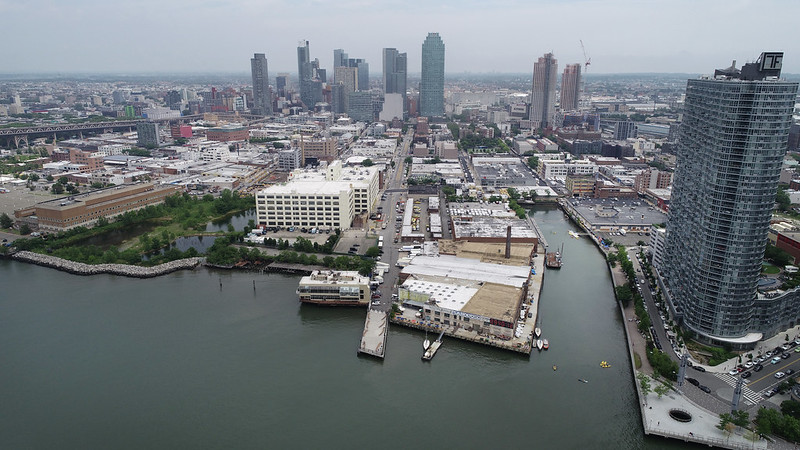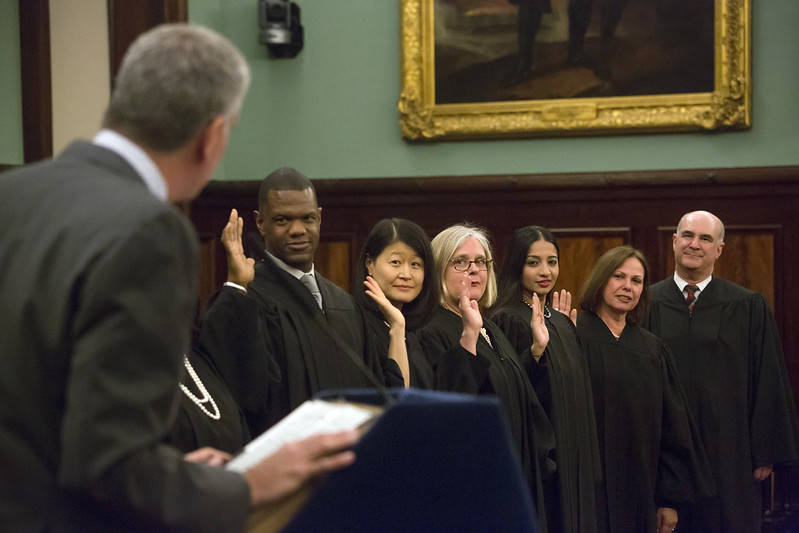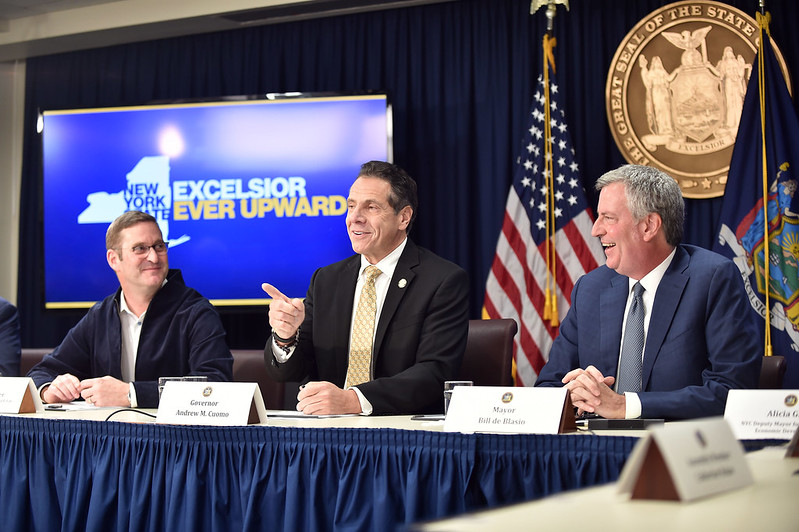Lessons from Amazon 'HQ2': Corporate Tax Incentives and Affordable Housing Need to be a Package Deal

The planned Amazon site (photo: Kevin P. Coughlin/Governor's Office)
This week marks the one-year anniversary of Amazon’s contentious withdrawal from its Long Island City plans. Meanwhile, the construction of 'HQ2’ is making steady progress in Arlington County, Virginia, and residents are preparing to welcome thousands of new Amazon employees to their neighborhoods. With its close proximity to Washington D.C., established infrastructure, and educated workforce, Arlington County was a natural choice for Amazon and has been an attractive market for years, with median sales prices steadily increasing between 5-8% annually. Since the announcement, however, housing prices have spiked by 12.6%, and many residents are blaming ‘HQ2’ for throwing the housing market into a frenzy.
Given the fact that the State of Virginia pledged $750 million in subsidies to attract Amazon to Arlington County, it is fair to consider the possibility that taxpayers may have financed their own affordable housing crunch. The most obvious solution to this problem would be to build more housing - yet Arlington is subject to restrictive zoning laws that prohibit multi-family zoning in most of the county. Public officials in Arlington and beyond need to recognize that large corporate tax incentives must be paired with zoning and permitting policies that allow cities to respond to their housing supply and affordability gaps.
The ‘HQ2’ bidding process showed that municipalities looking to revitalize their communities are eager to offer tax incentives in exchange for the promise of new jobs – a competitive bidding practice that has become increasingly popular. Supporters claim that these incentives are a net positive for cities, with tax expenditures offset by the increased revenue generated by economic growth and related "spillover" effects. Yet this analysis ignores an important part of the equation: the increased strain on infrastructure, public services, and affordable housing.
In anticipation of Amazon’s arrival, Arlington County has started making infrastructure improvements such as updating its public transit systems and roadways. Yet, its to-do list fails to include the construction of new housing - largely because less than 12% of the city is zoned for multifamily development, like apartment buildings. Those restrictions stand in stark contrast to Long Island City, which by some estimates added almost 20,000 units of high-rise housing between 2010 and 2020, one of the highest absolute growth rates of any neighborhood in the nation.
Ironically, the very construction boom that made Long Island City such a competitive candidate for an Amazon campus may have spurred the opposition that ultimately torpedoed the deal. Still, local governments that offer tax incentives to attract large corporations would do well to mimic the LIC landscape by lifting the ban on housing types that can accommodate a growing, economically-diverse population.
That said, many recipients of economic development incentives are starting to grapple more seriously with the disruptive effects they have on local housing markets, which ultimately hamper their ability to attract talent. Tech giants like Google (which received a 22-year tax break) and Apple (a $10 million tax break) are blamed for making San Francisco one of the most expensive housing markets in the country. In 2019, both companies made headlines for their respective pledges to finance housing initiatives in California, with the hope of mitigating the housing shortages they contributed to creating. But unless cities reduce the regulatory barriers to creating more housing for a wide range of households, these generous donations will fall far short of their ambitious goals.
Given the political motivation for elected officials to create jobs for the cities and states they represent, it is safe to say that we can expect more of these incentives in this upcoming election cycle, notwithstanding the high-profile breakup between Amazon and New York. Research on the actual costs and benefits of these incentives is still inconclusive and highly contested. However, looking at Seattle, San Francisco, and now Arlington County, one thing is quite clear. Economic development incentives must be paired with more housing construction to foster diverse and inclusive cities.
***
Brittany Mazzurco Muscato is a Graduate Researcher at the NYU Furman Center and a Master of Public Administration candidate specializing in Public Policy Analysis at NYU’s Robert F. Wagner Graduate School of Public Service. On Twitter @bamazzur.
***
Have an op-ed idea or submission for Gotham Gazette? Email This email address is being protected from spambots. You need JavaScript enabled to view it.
Judicial Discretion Isn’t a Fix for Bail Reform; Bail Reform was the Answer to Judicial Discretion

(photo: Ed Reed/Mayoral Photography Office)
As law enforcement and elected officials scream for a do-over regarding bail reform, they urge that judges should be given the discretion to remand people they believe to be dangerous. NYPD Commissioner Dermot Shea in a New York Times op-ed wrote, “We can trust New York State’s judges to use this discretion wisely and only for individuals who pose a real threat to the public or who continuously flout the justice system.” Shea’s boss, New York City Mayor Bill de Blasio, has been calling for giving judges discretion to decide a person’s dangerousness for years.
But the call for judicial discretion as a solution in search of a problem reveals that proponents are either ill-informed, naïve, or simply intent on returning to the racist and biased previous approach to bail.
By now, even those who argue for reforming bail reform agree that the system that had been in place for decades unconstitutionally and immorally punished people based on wealth. Governor Andrew Cuomo, as he signals a willingness to re-evaluate bail reforms, has said that “the system we had was discriminatory and biased.” That “system” was actually made up of individual judges.
Prior to January 1, 2020, it was common practice for judges of New York’s Criminal Courts to set bail that people without bank accounts couldn’t make. Stories are legion of people, almost exclusively people of color, held pretrial on Rikers Island, often on minor charges, because they lacked $500 or $1,000 to pay their way to freedom.
Judges were not required to set that bail. There was no law that mandated that kind of bail. Judges chose to do it.
In fact, 50 years ago the New York State Legislature reformed the bail laws to allow for other, less restrictive, forms of bail than cold hard cash. Alternative forms of bail like unsecured bonds that do not require any upfront cash payment have been on the books since 1970, but judges have steadfastly refused to utilize these statutorily authorized mechanisms despite repeated trainings, encouragement, and pleading.
Instead, in the exercise of their discretion, judges have chosen to incarcerate people based on wealth by using the harshest option available -- cash or insurance company bail bond – as a way of incarcerating poor people of color who are, after all, supposed to be presumed innocent. It is precisely this exercise of judicial discretion that had to be legislated out of existence.
While some law enforcement and elected officials warn of a bail reform apocalypse, it is critical to note that the judiciary, too, is clinging to the idea that money bail is sacrosanct. The revelations about the millions of people sent to Rikers Island because they couldn’t afford to pay their way to freedom are beyond dispute. There are countless stories of lost jobs, missed school, violence, and untold impact on physical and emotional well-being. Yet while there hasn’t even been any kind of publicly stated judicial remorse, let alone any mea culpas over the damage they inflicted, there are judges who bemoan bail reform and are trying desperately to return to the ways of the past.
Two judges, one from Nassau County and one from Albany County, chose to exercise their discretion by intentionally flouting the new law and setting cash bail that is now expressly forbidden by statute.
So, pardon those who cringe and rebel at the notion that bail reform needs a judicial discretion fix. If such a change is made and past is prologue, there will be an awful lot of people of color in pretrial detention after having been deemed to be “dangerous.” As the saying goes, fool me once, shame on thee; fool me twice, shame on me.
***
Steven Zeidman is a professor of law at CUNY School of Law. On Twitter @SteveZeidman.
***
Have an op-ed idea or submission for Gotham Gazette? Email This email address is being protected from spambots. You need JavaScript enabled to view it.
The Amazon Delivery We Still Need: Invest in Public Infrastructure, Not Corporate Welfare

(photo: Kevin P. Coughlin/Office of Governor Andrew M. Cuomo)
This week marks the one-year anniversary of the cancellation of the Amazon ‘HQ2’ Queens deal, which presents an opportunity for New Yorkers to reflect. That these types of destructive corporate welfare deals are still possible and that Amazon is still coming to New York City, albeit in a smaller footprint with fewer public subsidies involved, shows there is a lot still to be discussed around what - and who - our government prioritizes.
With the quick success last year of community groups, unions, and local elected officials assembled to fight the deal, opponents didn’t get the chance to make the bigger argument against the failed economic development ideas ‘HQ2’ represents.
The ‘HQ2’ deal was bad for New York City. Amazon dangled the promise of 25,000 jobs -- without committing to it -- in order to get what it wanted, which was public land quickly, cheaply, and with minimal public oversight. Why would our elected officials give well over $3 billion in subsidies and land to one of the largest, most profitable corporations on earth for an office they were already going to build and could easily afford, without requiring Amazon to make tangible commitments to the public good?
Simply by asking this question, opponents were labeled as naive anti-development radicals. Nevermind that we are backed by 40 years of research linking runaway economic and social inequality in America to neoliberal policies that shower public wealth on corporations, fail to deliver promised public benefits, and take money away from investing in public services. Economists across the political spectrum from the American Prospect to the Cato Institute all oppose corporate welfare.
However, the establishment’s consensus on economic development limited the ‘HQ2’ debate to the terms of the deal after the fact, not whether the deal should be made in the first place. Many Democratic officials still lazily point to decontextualized polls that claim to show that ‘HQ2’ was “popular” as though they came close to explaining its consequences.
This mindset has been disastrous for our city. While HQ2 failed, Atlantic Yards, Hudson Yards (where Amazon is heading), and even Ground Zero have all followed the same neoliberal model -- give away public wealth to private profiteers in exchange for vanishingly small public benefits.
As glass towers, a new sports stadium, or a mall disguised as a transit hub rise around our city, critical public institutions like NYCHA, CUNY, and the MTA crumble. Yet the media largely gives cover to the establishment by treating these as separate universes divorced from the interconnected decisions that they make about where to invest our public wealth.
No one in our political establishment is called “radical” for giving billions of dollars of public money and land to developers, corporations, and billionaires while over 90,000 New Yorkers are unhoused. No one is called “naive” for still arguing, despite all empirical data, that subsidizing luxury development will trickle down. No one has paid a political price for when these expected public benefits don’t materialize.
Opponents of the Amazon ‘HQ2’ deal were also falsely accused of not having an alternative vision for growth. The real issue is what value “growth” has in the late capitalism era of rising income inequality, racial injustice, and climate disaster. Given these challenges, we must rethink our economic priorities. If the 2010s can be summed up as “move fast and break things” the 2020s should be “slow down and fix things.” The practical solution is obvious: public investment in public infrastructure.
We’ve done this successfully in the past. Look no further than Amazon’s decision to open an office in New York City without public assistance. It wasn’t attracted to New York City because of tax incentives (though it will benefit from the incentives Hudson Yards received). It was attracted because of generations of public investment -- the city’s density, lubricated by public transportation; its workforce, nurtured by public education and housing; and its amenities, grounded around public parks, libraries, and the arts. These upfront investments created the shared public wealth that attracts individual ambition and innovation.
Instead of investing our wealth in growing these public institutions, the political establishment has been co-opted by big developers, corporate monopolies, and extremist billionaires that funnel it out of our city into offshore bank accounts. Instead of fighting against economic inequality, racial injustice, and climate disaster, this system fuels all three. We can no longer tolerate this.
Amazon has exploited this system skillfully and ruthlessly, which is why many of us still protest its presence in our city a year later. I’m running for Congress -- to represent the district Amazon ‘HQ2’ was going to call home until we stopped it -- because we have the chance to hold this failed system up to public scrutiny and to hold our elected leaders responsible for giving away our public wealth for nothing. We might not be able to kick Amazon out of New York City altogether, but we can rid ourselves of this system along with the establishment that defends it, and replace it with one that works for every New Yorker.
***
Peter Harrison is a Democratic candidate for U.S. Congress (NY-12) and an adjunct lecturer at Baruch College. He lives in Stuyvesant Town. On Twitter @PeteHarrisonNYC.
***
Have an op-ed idea or submission for Gotham Gazette? Email This email address is being protected from spambots. You need JavaScript enabled to view it.




